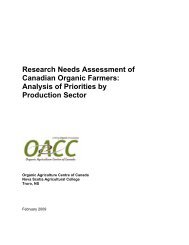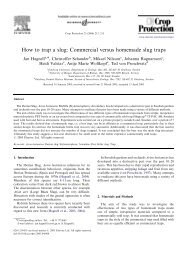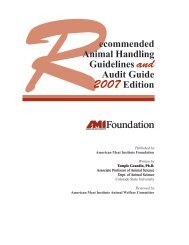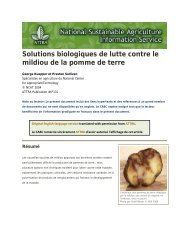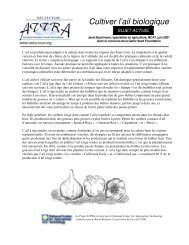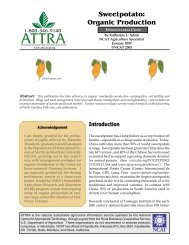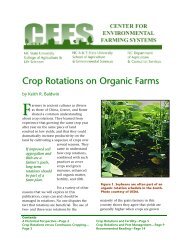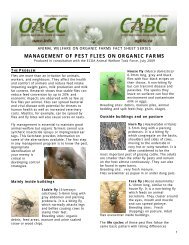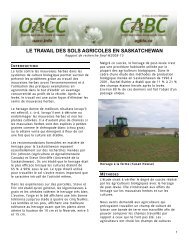Create successful ePaper yourself
Turn your PDF publications into a flip-book with our unique Google optimized e-Paper software.
millet can be planted from late Aprilthrough July at a rate of 15 to 20 poundsper acre. Pearl millet matures in 60 to 70days. In North Carolina studies, pearl milletwas not as readily killed by mechanicalmethods (mowing and undercutting) asGerman or Japanese millet.Japanese millet (Enchinochloa frumentacea).Japanese millet is an annual grassthat grows 2 to 4 feet tall. It resembles andmay have originated from barnyard grass.Japanese millet is commonly grown as alate-season green <strong>for</strong>age. If weatherconditions are favorable, it grows rapidlyand will mature from seed in as little as 45days. Japanese millet can be planted fromApril to July at a rate of 10 to 15 pounds peracre. It per<strong>for</strong>ms poorly on sandy soils.RECOMMENDED READINGSources CitedAltieri, M.A., and D.K. Letourneau. 1982.Vegetation management and biologicalcontrol in agroecosystems. Crop Protection.1:405-430.Andow, D.A. 1988. Management of weeds <strong>for</strong>insect manipulation in agroecosystems. InM.A. Altieri and M. Liebman (Eds.). WeedManagement in Agroecosystems: EcologicalApproaches. pp.265-294. CRC Press. BocaRaton, FL.Allison, J.R., and S.L. Ott. 1987. Economics ofusing legumes as a nitrogen source inconservation tillage systems. In (J.F.Power, Ed.) The Role of Legumes inConservation Tillage Systems. pp.145-150.Soil Conservation Society of America.Barnes, J.P., and A.R. Putnam. 1986. Evidence<strong>for</strong> allelopathy by residues and aqueousextracts of rye (Secale cereale). WeedScience. 86:384-390.Bending G.D., and S.D. Lincoln. 1999.Characterization of volatile sulphurcontainingcompounds produced duringdecomposition of Brassica juncea tissues insoil. Soil Biology and Biochemistry.31:695-703.Bollero, G.A., and D.G. Bullock. 1994. <strong>Cover</strong>cropping systems <strong>for</strong> the Central CornBelt. Journal of Production Agriculture.7:55-58.Bugg, R.L., S.C. Phatak, and J.D. Dutcher.1990. Insects associated with cool-seasoncover crops in southern Georgia:Implications <strong>for</strong> biological control intruck-farm and pecan agroecosystems.Biological Agriculture and Horticulture.7:17-45.Clark, A.J., A.M. Decker, and J.J. Meisinger.1994. Seeding rate and kill date effects onhairy vetch-cereal rye cover crop mixtures<strong>for</strong> corn production. Agronomy Journal.86:1065-1070.Clement, A.J., J.K. Ladha, and F.P. Chalifour.1995. Crop residue effects on nitrogenmineralization, microbial biomass, andrice yield in submerged soils. Soil ScienceSociety of America Journal. 59:1595-1603.Creamer, N.G., and M.A. Bennett. 1997.Evaluation of cover crop mixtures <strong>for</strong> usein vegetable production systems.HortScience. 32:866-870.Creamer, N.G., M.A. Bennett, B.R. Stinner, J.Cardina, and E.E. Regnier. 1996a.Mechanisms of weed suppression in covercrop-based production systems.HortScience. 31:410-413.Duke, J.A. 1981. Handbook of Legumes of WorldEconomic Importance. Plenum Press. NewYork, NY.Fawcett, R.S. 1987. Overview of pestmanagement <strong>for</strong> conservation tillagesystems. In R.J. Logan (Ed.). Effects ofConservation Tillage on GroundwaterQuality: Nitrates and Pesticides. pp. 17-37.Lewis Publishers. Chelsea, MI.Forney, D.R., and C.L. Foy. 1985.Phytotoxicity of products fromrhizospheres of a sorghum-sudangrasshybrid (Sorghum bicolor X Sorghumsudanese). Weed Science. 33:597-604.Fujii, Y., T. Shibuya, and T. Yasuda. 1992.Allelopathy of velvetbean: Its<strong>Organic</strong> Production—<strong>Cover</strong> <strong>Crops</strong> <strong>for</strong> <strong>Organic</strong> <strong>Farms</strong> 17



